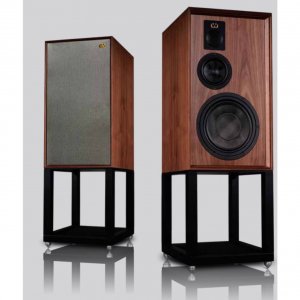I feel the same way about cheese. There's cheddar and sharp cheddar. What more can the world really need?
{Personally, I'd like more acoustic suspension choices} would require larger cabinets and today small is in, cheap to build, cheap to ship from China, easy to stock, and high profits on sales. They did a great job of selling small to the general public after all tech should be more compact not larger. That bumps into the laws of physics when building a device to produce a soundwave, sound waves didn't get smaller. |
Hey JohnK/Kenjit, I blocked you for a reason, and now you are harassing me via my virtual system. See, I know that you are Kenjit because you are the only person who ever directs this statement to me:
1. Kenjit has for a very long time inserted himself into my threads claiming I am having sonic issues, or dissatisfied with my system when I’m perfectly happy with it, even if able to critique it. 2. Kenjit is obsessed with the fact that I not only built my main speakers, but posted 100% of the designs and measurements online. 3. Kenjit has never heard my system so he has no idea if it is a good design or not. 4. Kenjit will talk trash about some aspect of stereo reproduction without ever coming to a specific set of recommendations, or able to demonstrate he has something better. 5. Bonkers take on the physics of speaker design, which is evident in your post:
|
| Post removed |
| Post removed |
| Post removed |
And in defense of cheese there is English Hollow, Top Hat bandaged, Chalet wheel Swiss, Wakker aged gouda, Gile baby Swiss (the best since Bahl Baby), brick curds etc. And that is only from one state. To bad that Erik will never taste them before making rash proclamations. johnk may or might not be Kenjit but it’s close enough for govt. work. |
I was being funny, I love cheese in all it’s form, except Velveta and pimento. Particular soft spot (pun!) for Stiltons. |
OP, I think you'd feel more at home here: http://cheeseforum.org/forum/index.php |
The 6” 2-way is the most versatile and practical speaker design for home stereo is why. A 6” woofer can go deep enough to blend with a sub, and high enough before breakup to match a dome tweeter and maintain good off axis linearity. Bigger woofer 2-ways of yesteryear had midrange issues or larger tweeters that couldn’t reach the top. |
| Post removed |
Andrew Jones talked about his considerations for speaker design in general, that are bass, size and efficiency. The debut product, Sourcepoint 10, he comes up with after joining MoFi turns out a good balance of these imo. With the 2-way concentric driver design, he was able to squeez larger 10" woofer into a larger cabinet comparable to Tannoy Eaton to enhance the scale of music that would otherwise be difficult reproduced by a normal size of bookshelfs or stand mounts. According to a reliable reviewer, this speaker also images quite well, leading me to believe it will handle more complicated genre of music like classical well. Although not superly deep, the bass is rated 42 hz at -6dB. I don't like a designer purposely boost the midbass in order to get better low bass extension. Its efficiency/sensitivity just passes 90dB, not superly high but is high enough to be considered high efficient speakers. I actually have a concern on a speaker with extremely high as 94dB or above because the noise floor of the amp can be audible. All these design elements were finetuned to sweet spots in SP 10. |
I remember "back in the day" when the designers of high quality British compact 2-way monitors discovered something interesting. How their speakers actually sounded -- in the room. They determined that the "average" listening room was not very large and definitely not acoustically treated. So, side reflections were a factor. The wide dispersion characteristics of those small mid/woofers were actually a detriment to sound quality. Taking the driver size up a notch, thus intentionally limiting dispersion actually produced more detail, focus and imaging in the average room than the smaller diameter drivers. Thus was born the next generation of polite British 2-way monitors. |
@waytoomuchstuff Okay but how big? Can we have some examples?
|
I could see some truth to it. The design of Tannoy HDF series from Eaton (10"), Cheviot (12") to Arden (15") may carry that trend. These speakers do not throw huge soundstage like B&W (take 805s as an example) but focused in image.
|
Old Jensen 4 way from mid late 70;s rocked with a sansui 7070 at my cousins the i was a kid, but this was back in 83-84 maybe. big monkey coffins, but looked wicked, which was the motivation for my CV at15, d9, se380 pairs i had. now a days must have wiff approval. she approves the energy rc-70. only wish had them in wood veneer. great bookshelf is energy rc-10 and the BIC America 62 bookshelf. tweeter needs a good 300 hours to softn and relax, if your patient, worth the wait. new rc-70;s, i remember took over 400 hours to become perfect, loosen the surrounds, etc etc. loaded the old sherwood 5 disc carousel, repeat all, went down every other day, after trying to remember what they sounded like night before. yeah right.
don't knock the BIC America 62 bookshelf, great bass, amazing presence from the VIFA tweeters. remember, 300 hours, and I still taped a piece of cut cotton t-shirt over the, they are friggin wicked now.
|




